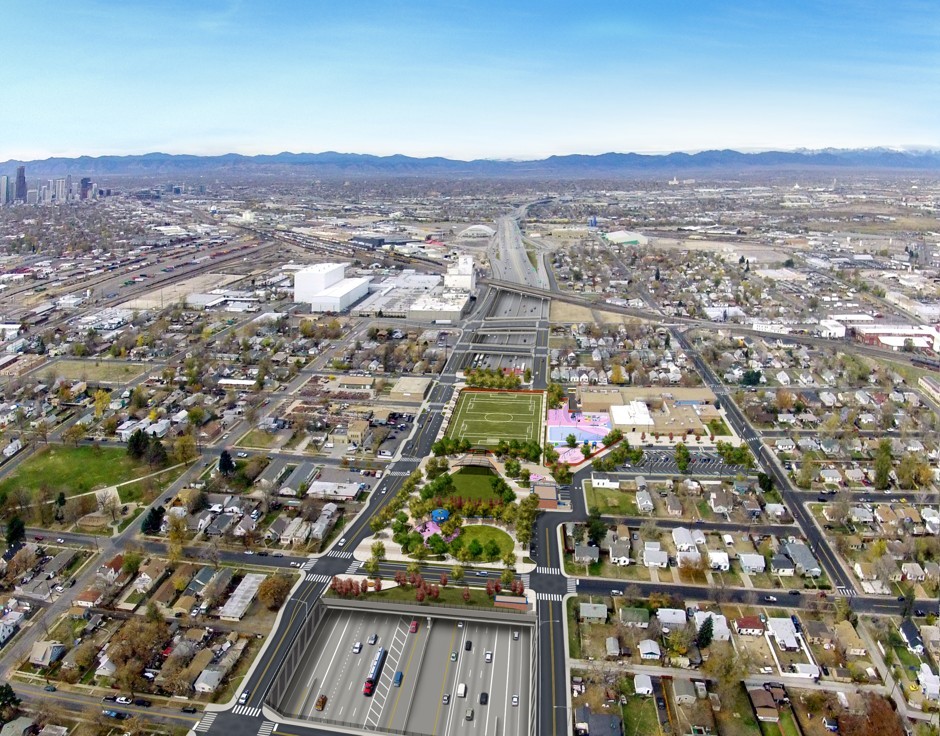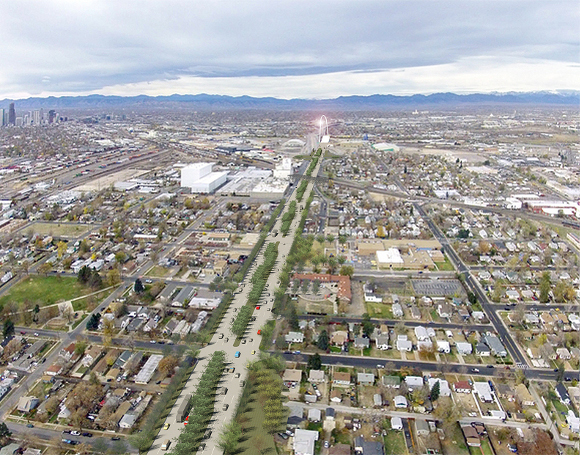- Who We Are
- What We Do
- Our Issues
- Our Projects
- Sprawl Retrofit
- Highways to Boulevards
- CNU/ITE Manual
- Health Districts
- The Project for Code Reform
- Lean Urbanism
- LEED for Neighborhood Development
- Missing Middle Housing
- Small-Scale Developers & Builders
- Emergency Response
- HUD HOPE VI
- Rainwater in Context
- Street Networks
- HUD Finance Reform
- Affordable Neighborhoods
- Autonomous Vehicles
- Legacy Projects
- Build Great Places
- Education & Trainings
- Charter Awards
- Annual Congress
- Athena Medals
- Resources
- Get Involved
- Support CNU
- Public Square
History and Context
For over half a century, urban highways in North America have disproportionately impacted minority communities. Running through historic neighborhoods, they have severed connectivity, demolished homes and businesses, and left blight in their wake. In Denver, the construction of Interstate 70 inflicted its ill effects on three urban neighborhoods: Elyria, Swansea, and Globeville.
In those historic minority communities, residents were cut off from opportunity, access, and needed services. Now, like many mid-20th Century highways, I-70 in Denver has reached the end of its life cycle—and the viaduct along its route is being torn down.
However, instead of replacing it with a boulevard, the Colorado Department of Transportation (CDOT) has begun a $1.2 billion plan to tear down the viaduct, bury part of the highway, add four more lanes, and expand toll lanes, shoulders, and service roads. To do this, the state has acquired and demolished 56 residences and 17 businesses—including the neighborhood’s only source to purchase food. The plan also includes the demolition of Swansea Elementary School’s playground and the school building itself would be directly adjacent to the 14-lane highway.
Proposal
Prior to CDOT's commitment to expanding the highway, a group called Unite North Metro Denver devised an alternate proposal: Reroute interstate traffic to the north, and redesign I-70 as a bike- and pedestrian-friendly boulevard. Such a plan would cut noise and air pollution while bringing new investment opportunity to neglected neighborhoods. A tree-lined boulevard, with roundabouts instead of interchanges, would re-establish the community grid, free up land for development, and raise property values.
As the debate over I-70 has grown, national and state groups have taken notice. Environmentalist leader the Sierra Club filed a lawsuit against EPA over the proposed widening. Meanwhile, a recent report by Colorado Public Interest Research Group advises against the expansion. The report estimates $58 million in taxpayer dollars will be wasted on a project that encourages more driving and doesn’t include expansion of mass transit.


Under CDOT’s proposal, burying part of the expanded I-70 would involve digging below the water table and into polluted soils. A partial 800-foot grass cover is proposed, which will be isolated between two large frontage roads, creating an isolated “recreation island” inaccessible by pedestrians or bicycle. Moreover, the data used to justify the project is more than a decade old and ignores trends of lower-than-expected motor vehicle use.
“Instead of a grade-separated, widened superhighway, dedicated to cars and trucks,” the United North Metro Denver imagines, “a tree-lined, pedestrian-friendly boulevard emerges. Long-broken bicycle pathways are re-established.” Roundabouts could replace interchanges, freeing up land for development, tax revenue, and potential affordable housing. The traditional grid is reestablished, healing the long-separated neighborhoods.
Designed through a contextual and community-driven process, the new boulevard would open up and connect several neighborhoods and districts—including the National Western Complex, a set of historic venues associated with the National Western Stock Show and other events. Denver citizens recently voted to fund a restoration of the complex.
City council members over the year have endorsed the boulevard option. Former city Councilman, Rafael Espinoza, has publicly embraced this planning approach. “For me, it’s not a matter of opinion — there’s hard science behind this,” he told The Colorado Independent. “Other communities have gotten wise to the fact that you get overall better communities by removing [large central highways], not expanding them. Rather than improving the quality of life in the core, we go to the status quo of displacing people and expanding urban sprawl.” Current Councilwoman Candi CdeBaca continues to oppose the Central 70 expansion.
Current Plans
When CDOT’s plan was first revealed, community group Ditch the Ditch responded and raised environmental justice concerns. In addition to air quality issues, lowering I-70 below grade has the potential to contaminate groundwater sources, a fact that CDOT itself readily admitted when it shelved proposals to reconstruct I-70 as a tunnel.
With the support of the Sierra Club, several local organizations and neighborhood associations filed an injunction against the project on the grounds that it had not adequately addressed the environmental concerns for the community. As of December 2018, CDOT chose to settle the lawsuit and agreed to contribute $550,000 to an independent health study that will provide a greater understanding of public health and environmental hazards in the Globeville, Elyria and Swansea neighborhoods.
CDOT first proposed the reconstruction of I-70 in 2004. Fifteen years later, it runs contrary to recent transportation developments in Colorado. On the November 2018 ballot, voters turned down two proposals (Propositions 109 and 110) to allocate billions of dollars of funding to highway widening and expansion across the state. The state also elected Jared Polis as governor, who campaigned on the dual issues of cutting vehicle emissions and increased mass transit. In light of these developments, the Central 70 project appears to be behind the times—and proposals such as those by Unite North Metro Denver are more in line with current demands.
CDOT continues to move the Central 70 project forward, but it remains opposed by the community members around it. Although it may appear too late, many other cities and communities have stopped highway projects mid-construction before and saved their neighborhoods from a road's negative impacts.


















